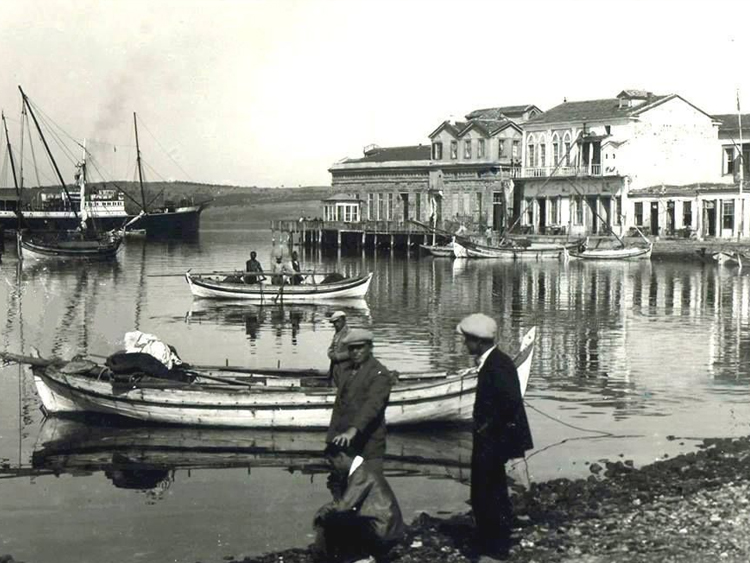History of Ayvalık
In this part, you will find the history of Ayvalık, where the name came from, and much more.
The name Ayvalık, which has been chosen as a settlement since ancient times, is thought to come from the Greek word Kydonia. “Kydon” means quince, and “Kydonia” means quince garden. It was also called Cithana and Taliani in the past.

Ayvalık in Ancient Ages
In ancient times, the islands off Ayvalik were called “HEKATONNESOI.” This name comes from the god Apollo. “Hekatos” is one of the epithets of Apollo. It is mentioned in ancient written sources that there was an Apollon temple in this region. Nasos-Nesos, Kydonia, Chalkis, and Pordoselene settlements are also mentioned in ancient sources.
The material collected from surveys gives evidence of habitation during the ARCHAIC (750/700 BCE-480 BCE), HELLENISTIC (330 BCE-30 BCE), ROMAN (30 BCE-395 CE), and BYZANTINE (395 CE-1453 CE) Periods.
Ayvalık in the Byzantine Period
Byzantine ceramics can be seen under the areas where today’s old urban site is located and in the ancient settlement on the Alibey Island side of the bridge between Alibey Island and Lale Island. On the other hand, there are layers of Late Byzantine and Early Ottoman Periods under modern-day Ayvalık. According to the ceramic finds on the surface, the settlement on the island ended, and the habitation continued on the mainland. During the Byzantine Period, Ayvalık was first moved to the side of the prominent hill, and the city developed around this center in the following years.
Between 1439 and 1453, Ayvalık and its surroundings passed from the Genoese domination to the Ottomans. In those years, Ayvalık was built on a hill overlooking the port. Agriculture, trade, and culture significantly developed thanks to the port connection. The Greeks, who make up more than half of the population, have made the region a cultural center of their own.
When Hasan Pasha became the Grand Vizier, an edict was issued in 1772 recognizing the independence of Ayvalık. After this date, Ayvalık started its foreign trade.
Semi-independent Ayvalık joined the Greek independence movement in the first half of the 19th century. Clashes broke out between Ayvalık and the surrounding Greek and Turkish cities. The Greeks do not lay down their arms and flee to the islands when the government sends troops to these areas. The refugees were allowed to return after ten years. During the Balkan Wars and the First World War, the Greeks revolted. On May 29, 1919, the Greeks took Ayvalık. However, Ali Çetinkaya created an Ayvalık front with his gathered volunteers. Turks took back Ayvalık on 15 September 1922.
Ayvalık’s Brightest Era
In Ayvalık’s history, the settlement experienced its prime days in the second half of the 19th century and the beginning of the 20th century. Since then, an urban texture has emerged, one of our time’s rarest examples of neoclassical architecture. Magnificent churches built during this time are used as mosques today.
On May 6, 1919, on the second day of the Greek occupation of Izmir, the Association of Denial of Annexation (Redd-i Ilhak Cemiyeti) was established in Balıkesir. Thus, the first bullet of resistance was fired in Ayvalık in our national struggle against the Greek army, which set out to seize Ayvalık. On May 28, 1919, the 172nd Regiment of Ayvalık showed armed resistance to the Greek forces that landed in Ayvalık. Lieutenant Colonel Fahri Bey, a People’s Resistance officer under the command of Lieutenant Colonel Ali Çetinkaya, was martyred. On May 29, 1919, Ali Çetinkaya and the gathered volunteers formed the Ayvalık Front according to the Treaty of Lausanne. Ayvalık Greeks migrated to Greece. Turks living in Lesbos, Crete, and Macedonia settled in Ayvalık.
The Great Leader Atatürk visited Ayvalık on April 13, 1933.
Ayvalık, connected to Balıkesir in 1786, was liberated from enemy occupation on September 15, 1922.
How can we help you?

